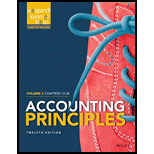
Accounting for Receivables:
Receivables are defined as the amounts that are due to a firm by its customers and other parties. Receivables include all those assets that arise due to the primary operations of a firm and those representing cash that is to be collected from all external parties who owe money to the firm.
Receivables are broadly categorized into trade-receivables and non-trade receivables. Trade receivables refer to those receivables that occur due to the sale of goods and services in the normal course of business. Non-trade receivables refer to the amounts that occur due to third parties from transactions outside the primary course of business.
To determine: The difference between an account receivable and a note receivable.
Explanation of Solution
The difference between an account receivable and a note receivable are explained as below.
Accounts receivable : Accounts receivable can be defined as the amounts which customers owe to an organization. Accounts receivable are the results of sale of goods or services. Usually accounts receivable are collected within a time period of 30 to 60 days.- Notes receivable: Notes receivable can be defined as a written promissory note. It can also be referred to as a note required for collection of interest and is collected within a time period of 60 to 90 days. Both accounts receivables and note receivables are the results of sales transactions.
Hence, the difference between an accounts receivable and a notes receivable are explained as above.
Want to see more full solutions like this?
Chapter 9 Solutions
Accounting Principles, Volume 2: Chapters 13 - 26
- I need assistance with this financial accounting problem using appropriate calculation techniques.arrow_forwardI am trying to find the accurate solution to this financial accounting problem with appropriate explanations.arrow_forwardIf Summit Corp. reports Salaries and Wages Expense of $520,400 for the year, and the beginning and ending balances of Salaries and Wages Payable are $22,100 and $25,300respectively, what is the amount of cash paid to employees during the year?arrow_forward
- I am searching for the right answer to this financial accounting question using proper techniques.arrow_forwardKindly help me with this General accounting questions not use chart gpt please fast given solutionarrow_forwardHii teacher please provide for General accounting question answer do fastarrow_forward
- I am looking for help with this general accounting question using proper accounting standards.arrow_forwardPlease provide the correct answer to this general accounting problem using valid calculations.arrow_forwardCorvex Industries had sales of$620 million last year, and its production facility operated at 80% of capacity. The actual amount of fixed assets was $250 million. What total amount of fixed assets will Corvex need if it plans to increase sales by 30%?arrow_forward
- I am trying to find the accurate solution to this general accounting problem with appropriate explanations.arrow_forwardI need assistance with this financial accounting problem using appropriate calculation techniques.arrow_forwardI need help with this general accounting question using the proper accounting approach.arrow_forward

 AccountingAccountingISBN:9781337272094Author:WARREN, Carl S., Reeve, James M., Duchac, Jonathan E.Publisher:Cengage Learning,
AccountingAccountingISBN:9781337272094Author:WARREN, Carl S., Reeve, James M., Duchac, Jonathan E.Publisher:Cengage Learning, Accounting Information SystemsAccountingISBN:9781337619202Author:Hall, James A.Publisher:Cengage Learning,
Accounting Information SystemsAccountingISBN:9781337619202Author:Hall, James A.Publisher:Cengage Learning, Horngren's Cost Accounting: A Managerial Emphasis...AccountingISBN:9780134475585Author:Srikant M. Datar, Madhav V. RajanPublisher:PEARSON
Horngren's Cost Accounting: A Managerial Emphasis...AccountingISBN:9780134475585Author:Srikant M. Datar, Madhav V. RajanPublisher:PEARSON Intermediate AccountingAccountingISBN:9781259722660Author:J. David Spiceland, Mark W. Nelson, Wayne M ThomasPublisher:McGraw-Hill Education
Intermediate AccountingAccountingISBN:9781259722660Author:J. David Spiceland, Mark W. Nelson, Wayne M ThomasPublisher:McGraw-Hill Education Financial and Managerial AccountingAccountingISBN:9781259726705Author:John J Wild, Ken W. Shaw, Barbara Chiappetta Fundamental Accounting PrinciplesPublisher:McGraw-Hill Education
Financial and Managerial AccountingAccountingISBN:9781259726705Author:John J Wild, Ken W. Shaw, Barbara Chiappetta Fundamental Accounting PrinciplesPublisher:McGraw-Hill Education





